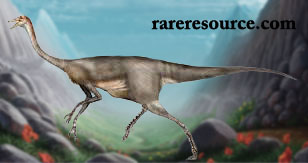Dinosaur a long extinct species walked the earth during the Triassic period 231.4 Million years ago. These wonder creatures have movies made on them and palaeontologist have spent decades trying to decode their existence. These creatures prominently found during the Jurassic period were both land breeding and winged-air flying animals that dominated both land and sky. Soon due to climatic changes and natural calamity their existence was endangered gradually fading away to extinction.

This Dinosaur belonged to a very diverse group with many different species. Ornithomimids is one such specie that was distinct it's built and characteristics. The family of (ornithomimids) originally gets its name from the Greek language translating it to bird mimics. These bird mimics have an interesting story attached to them, these dinosaurs did not hold any resemblance to flight taking birds or as simply put as birds that capable of flying long distances such as Eagles or crows. Ornithomimids closely represented birds that were impaired of flying distances for example Emus and ostriches.
Scientist even today mention that ostriches are descendants of the extinct dinosaur specie of Ornothominimids. The uncanny resemblance reminds them of the extinct creature who had long thin legs that support a rounded body which then extended to a long slender neck that over looked a small head and a like mouth. This creature was an omnivorous species and survived both on herbivorous and carnivorous diet.
Place of emergence and discovery of the ornithomimidsOrnothomomimosaurs were first discovered by the famous palaeontologist named Othniel Charles Marsh, in the year 1890 where he first dug out parts of the dinosaur such as partial hands and fossils of their leg. Initially when he was on a hunt of fossils he stumbled upon only a few parts of the unnamed disnosuar specie; after further digging they gradually were able to find all the pieces of the fossil and were able to name and discover a new species of dinosaur named ornithomimids.
When this fossil was first found it was difficult to conclude which specie did it actually belong to, with unusual body structure and identical fossil this was then put under the wastebasket taxon effect- this is usually a phenomena when palaeontologist have no idea as to which does an animal belong to, this can also hold reference to lack of research or work in progress kind of discoveries. One such being ornithomimus. While the first Ornothomomimosaurs was discovered in 1890 scientist were trying to find others of its kind to form a taxon. The second Ornothomomimosaurs was found the year 1917 by Henry Fairfield Osborn.
The era of 1970s and 1980's is also known as the golden period for Ornothomomimosaurs as this was the period that marled the emergence and discovery of many fossils of this genus. This lead to an ignition of hope in many other palaeontologist of the 1990's and 2000's period as they studied and brought together the primitive and advanced forms of science behind the existence of dinosaurs.
As a part of scientific classification Ornothomomimosaurs are classified together withManiraptoriformes,this specie also was discovered by Mr Holtz in the year 1995.
Maniraptoriformes are commonly known as hand graspers owing to their active forelimbs which are far more powerful and grander to that of primitive theropad group. Another group that holds close resemblance to the ones mentionedabove is the Alvarezsauridae as their attributes closely resemble to that of ornithomimosaurs.
The remains of ornithomimosaurs were most prominently found in regions of North America and Asia, having said that Pelecanimimus a dinosaur belonging to the ornothomimosaur family's fossila were dug out in Spain. Thus indicating the presence of ornithomimosaurs could be traced across Europe, Asia and America. This indicates clearly the distribution of this kind of dinosaur being wide spread across the globe.
| Ornithomimids facts: | ||||||||
|
||||||||